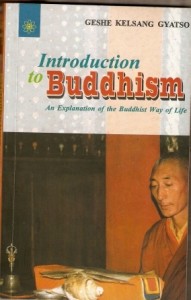Buddhism Made Easy: Book Review

 Title: INTRODUCTION TO BUDDHISM
Title: INTRODUCTION TO BUDDHISM
Author: Geshe Kelsang Gyatso
Pages 146; Price: Rs. 200/-
New Age Books, Naraina Phase-I, New Delhi-28
Introduction to Buddhism makes fascinating reading. Author, Geshe Kelsang Gyatso, who is a fully accomplished meditation master and internationally renowned teacher of Buddhism, strongly believes that Buddhism has great relevance even today. After reading the book, it is difficult to disagree with him because the teachings and practices taught by Buddha are timeless, and universally applicable. Though the 146-page book is primarily targetted at the West, it is no less useful to the seekers of truth in our part of the world. It is divided into three parts.
What is Buddha, what is karma, what is Meditation, understanding the Mind, and the Buddhist way of life are amongst the subjects of basic Buddhism that form the core of Part One. While the Path to Liberation and issues related to renunciation are elaborated in Part Two, the last and third part of the book speaks about the Path to Enlightenment.
Buddha gave 84-thousand teachings. He said every thing depends upon the mind. But what is mind? Is it the brain or some other part or function of the body? No, mind is not brain but it is some part of the body which is difficult to identify.
Says the author, ‘It (mind) is a formless continuum that functions to perceive and understand objects. Because the mind is formless, or non-physical, by nature, it is not obstructed by physical objects’. The way Gyatso unravels the mysteries of mind in its three stages – gross, subtle and very subtle, sustains the interest of the reader and makes one agree with his basic hypothesis that if we wish to be free from problems, we must learn to maintain a peaceful state of mind ‘by practicing Dharma sincerely and purely’.
While on the issue of Karma (this Sanskrit word means action), the author makes a valiant effort to demystify the subject and underscores the need to check the mind rather than worry about our karma. ‘All bodily and verbal actions depend on mental actions because they are all preceded by a mental intention to act. Every action we perform leaves an imprint on our very subtle mind, and each imprint virtually gives rise to its own effect. Our mind is like a field, and performing actions is like sowing seeds in that field’.
Our mind has no freedom to remain and no choice about where to go. We are blown to the place of our next rebirth by the winds of our Karma. So, it is necessary to avoid non-virtuous actions. If anyone knowingly continues to commit non-virtuous actions, shall we call him a blind person or a person with closed eyes? The Buddhist scriptures describe such a person as one with perfect eyesight who walks straight off the edge of a cliff. Buddha taught many methods for purifying negative karma. The Mahayana Sutra of the Three Superior Heaps tells one such powerful practice. This Sutra is given in the Appendix of the book.
Forty-nine days after Buddha attained enlightenment, he gave his first teaching. And it was the Sutra of the Four Nobel Truths in which he explained about true sufferings, true origins, true cessations and true paths (Page 51). Samsaric rebirth such as our present birth is called ‘true suffering’ because it is the basis of all other sufferings and delusions; and delusions and actions motivated by delusions are called ‘true origins’ because they are the source of all sufferings. Therefore, ‘true cessation’ becomes the Liberation because it ends once for all delusions, and sufferings. Writing about ‘renunciation’, the author makes an interesting observation. ‘We develop renunciation by contemplating the many faults of samsara… why it is necessary to contemplate sufferings such as birth, ageing, sickness and death…. The reason is that by meditating on these sufferings we realise that the very nature of samsaric existence is suffering, and that until we escape from samsara we shall have to experience the same pains in life after life. This induces a strong wish to escape from samsara by abandoning its cause, self-grasping. This wish is renunciation….’
At the end of the explanation, the author poses the question: what is the goal of life – liberation from sufferings for ourselves or the sake of all human beings. He himself replies: ‘the most meaningful use to which we can put our precious life is to attain great enlightenment, or Buddhahood, for the sake of all living beings’ (Page 69). That goal is achievable by relying on Buddha’s Mahayana teachings, according to Gyatso. He explains at length the Bodhisattva’s way of life and how it is lived by practicing the six perfections of giving, moral discipline, patience, effort, mental stabilisation, and wisdom. If we wish to become enlightened and yet don’t practice the six perfections? Well, then we are like some one ‘who wants to go somewhere but doesn’t actually set out on the journey’.
About 100 illustrations and a 10-page glossary make the reading an enriching experience to the uninitiated in the story of Buddha, and Bodhichitta. Printing is top class
Reviewer: Rama Rao.
-
Book Shelf
-
 Book Review
DESTINY OF A DYSFUNCTIONAL NUCLEAR STATE
Book Review
DESTINY OF A DYSFUNCTIONAL NUCLEAR STATE
- Book ReviewChina FO Presser Where is the fountainhead of jihad?
- Book ReviewNews Pak Syndrome bedevils Indo-Bangla ties
- Book Review Understanding Vedic Equality….: Book Review
- Book Review Buddhism Made Easy: Book Review
- Book ReviewNews Elegant Summary Of Krishnamurti’s teachings
- Book Review Review: Perspectives: The Timeless Way of Wisdom
- Book ReviewNews Rituals too a world of Rhythm
- Book Review Marx After Marxism
- Book Review John Updike’s Terrorist – a review
-
-
Recent Top Post
-
 NewsTop Story
What Would “Total Victory” Mean in Gaza?
NewsTop Story
What Would “Total Victory” Mean in Gaza?
-
 CommentariesTop Story
The Occupation of Territory in War
CommentariesTop Story
The Occupation of Territory in War
-
 CommentariesTop Story
Pakistan: Infighting in ruling elite intensifies following shock election result
CommentariesTop Story
Pakistan: Infighting in ruling elite intensifies following shock election result
-
 CommentariesTop Story
Proforma Polls in Pakistan Today
CommentariesTop Story
Proforma Polls in Pakistan Today
-
 CommentariesTop Story
Global South Dithering Away from BRI
CommentariesTop Story
Global South Dithering Away from BRI
-
 News
Meherabad beckons….
News
Meherabad beckons….
-
 CommentariesTop Story
Hong Kong court liquidates failed Chinese property giant
CommentariesTop Story
Hong Kong court liquidates failed Chinese property giant
-
 CommentariesTop Story
China’s stock market fall sounds alarm bells
CommentariesTop Story
China’s stock market fall sounds alarm bells
-
 Commentaries
Middle East: Opportunity for the US
Commentaries
Middle East: Opportunity for the US
-
 Commentaries
India – Maldives Relations Nosedive
Commentaries
India – Maldives Relations Nosedive
-
AdSense code



















